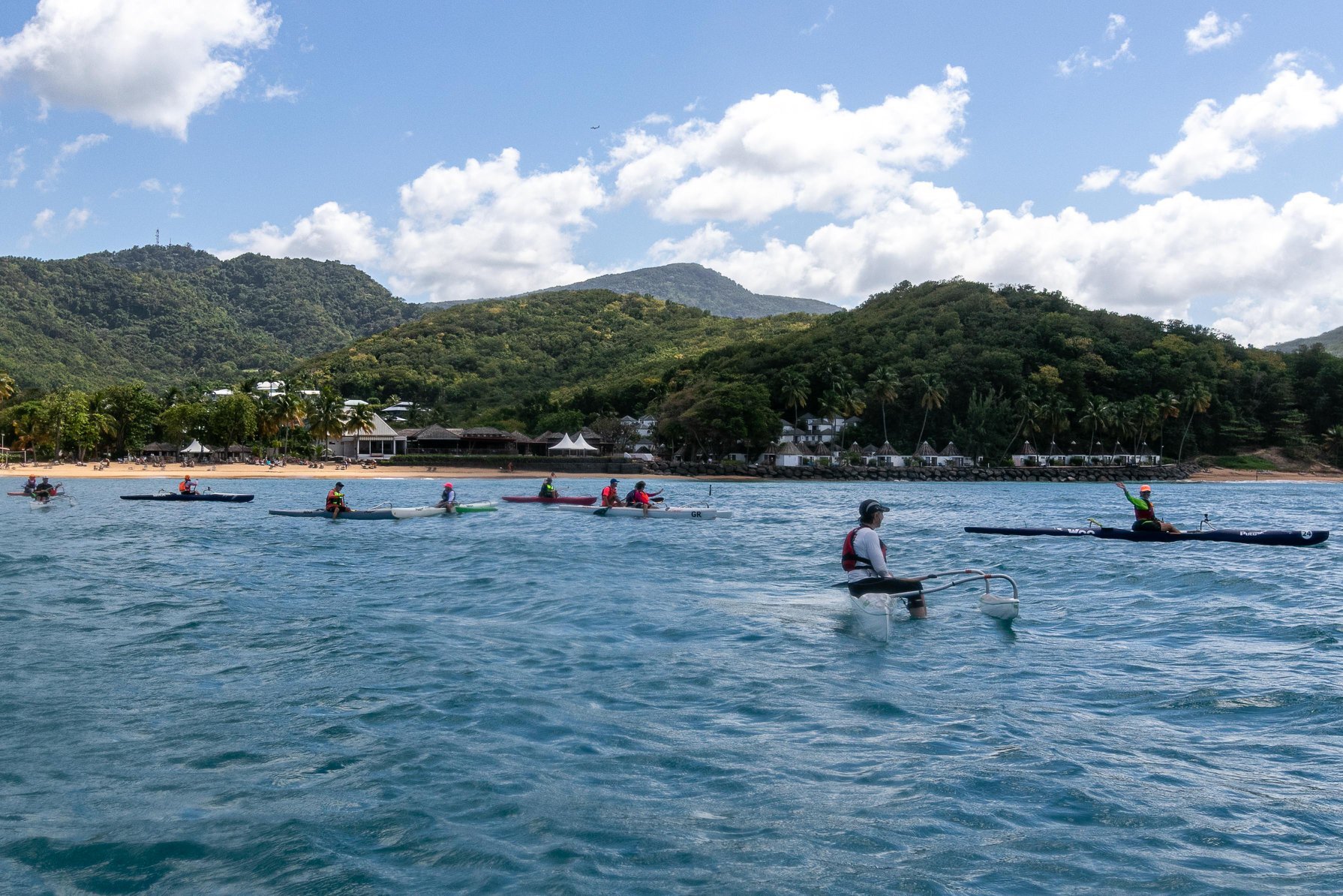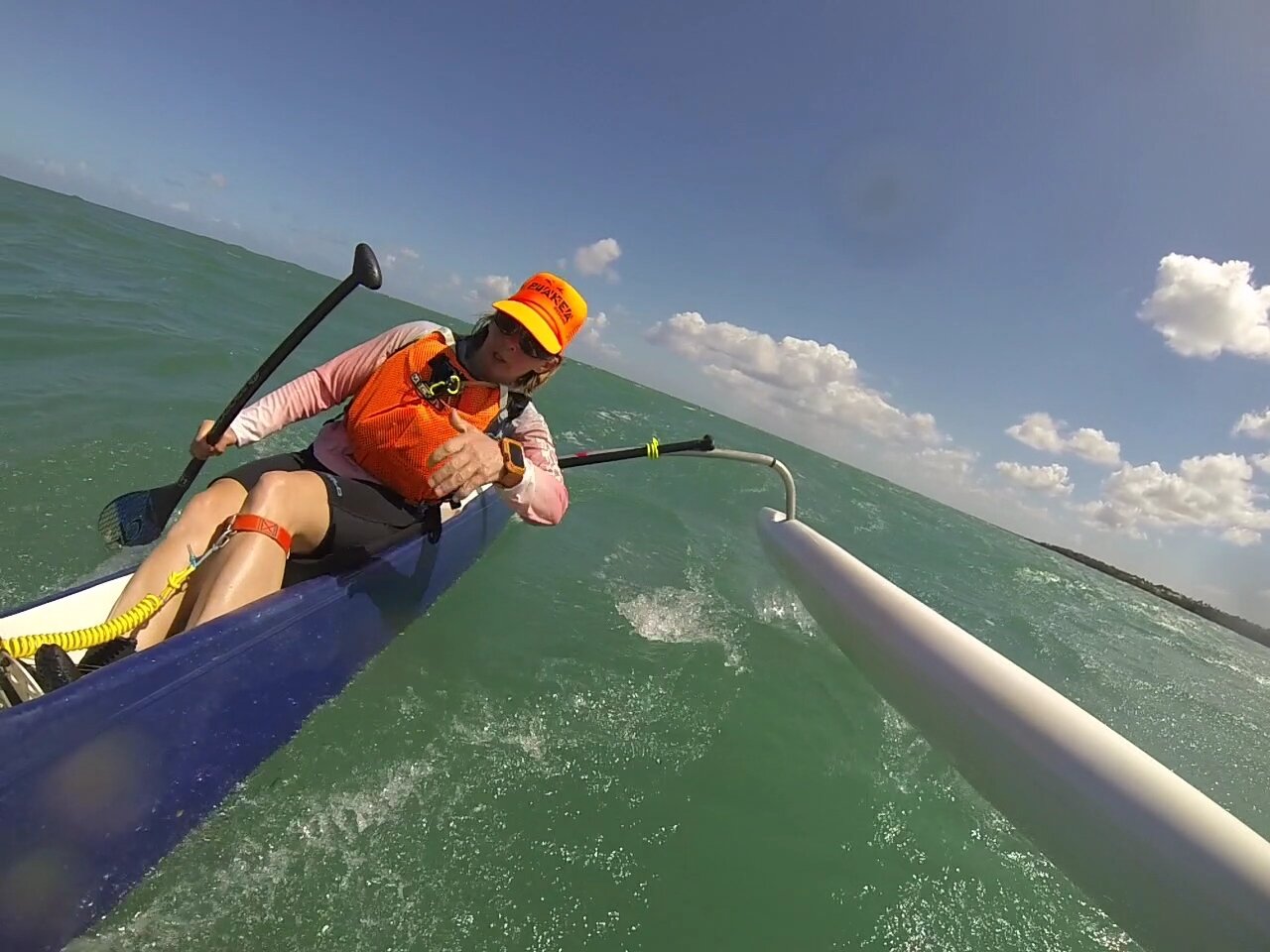It is March 2021, and I have spent more seat time in my Puakea Kahale than ever, in large part due to the need for social distancing. My local club started going out in our 6-man canoes late last summer, and several of us had been going out together in the smaller 1 and 2 seaters, but for a number of reasons I am still adhering to strict social distancing guidelines and not participating in any group sport activities or races. And while I miss the camaraderie of the big boats, the wind and waves and I have gotten quite close during the pandemic. If you want to get good at downwind, you have to paddle downwind. Solo. As much as possible.
In January 2020 I attended the Woo downwnd camp for the third year in a row. My skills had improved greatly, and I paddled the Woo Outrigger, French-made Feline as much as possible, as it was similar to the Kahele in length and volume. I did not huli once, no matter how tempted the Feline was to flip me, and I found some considerable speed and reasonable consistency on our daily runs.
My French coach Alain remarked that both my paddling and my French language had improved. There is no better way to stroke a paddler’s ego than to notice something they suspect: improvement. I recognized, however, that I would do much better on a Kahale, principally because it is lighter and has the improved steering with spring return rudder.
At the airport in Pointe-de-pietre in February 2020, as paddle camp wound down and we all returned to our home countries via this small international airport, I saw my first notices about travel restrictions into the USA due to coronavirus. A flight headed toward Miami earlier in the day returned a passenger who would not be allowed to depart there. Passengers who had been to inland China had to get rerouted onto New York bound planes, like mine. By the end of February I felt like I had a virus, though the news was not very clear as yet, and while I noticed the strange symptoms of the virus, I thought little of it until later. Within a few weeks restrictions increased, and the local club’s future went into limbo. I went out into the Atlantic Ocean by myself and started getting to know it quite well. For the duration of 2020 until now, my local waters are my university.
It had been a couple of years since I had started reading and then rereading WAVES by Fredric Raichlen, and while I got the basics I had not ever really seen my local waters as a system I could study. Having always paddled along with the bigger boats in the club, where surfing was seldom our focus, I tagged along regardless of wind conditions. But on my own I began to study the wind direction and tides. Soon I recognized the telltale signs of downwind runs, the curling horsehead waves running in the same direction. In my local waters sometimes these wave train patterns are only a couple of hundred feet wide or even less. Within these conveyor belt systems I discovered I could do 1 kilometer runs over and over again.
There are about seven small breakers in this image. A dark line behind me and closer to the horizon is another breaker. The further out I go, the bigger the swell. Closer in, the waves bunch up on the shallow sand.
I live on Long Island Sound, where on any given day, as long as I have 10 knots or better wind, I can downwind north, south or west. 16 knots is optimal for solo downwind. But approaching 20 knots, solo paddling is ill-advised. East directed waves will push me out to open water, so despite the temptation, I never downwind away from the shore even if the windspeed is below 15 knots. One of the key insights to downwind is that the waves actually don’t need to be big. As long as wave trains are moving in generally the same direction, even small bumps are surfable. In the video below, I am teaching a friend how to catch the swell rolling to the north. I can see the low bumps ahead, and I know more are coming behind me. So I keep a steady pace, and when I feel the stern lifting behind me, I pick up my stroke to match the speed of the wave. When they are the same, which is something you basically can both see and feel, you can let the momentum of the wave puch you. In this way, downwind paddling technique is more of a high intensity sport. You will cycle through speeds with intermittent bursts of power. This might look like flat water to you, but it is not. The swell bumps have a direction and a speed.
In the next video, from 2019, I have stronger swell, which a decent app like Windy will give you in Kj or kilojoules. At this stage in my paddling I knew the basics of what to look for and my timing was improving. Later in 2020, however, I found I had the ability to really hammer the paddle blade in and pull myself onto the face of a wave just so, to drop ono the incline like a surfer on a surfboard. The only way to get the feel for this is to go out in any kind of swell, even if it seems tiny, and try to ride it.
To close out this brief blog on downwind, the power is in the wave, the ability to catch that power takes immersion. Study your local waters for the telltale signs of downwind conditions, and even if they are small, go after them. It will make catching waves of all sizes easier. And once you really get to know your local conditions, you will know what to look for in other conditions, as well as what the bathymetry suggests by the waves above it. Basically, the top waves are travelling in circles, like a conveyor belt rollers, with their patterns often suggestive of what the sea floor looks like beneath them, as they roll against the sea floor and bunch up. These patterns will change with tidal height and flow. In this last video, the water is brownish from the silt churned up by a storm. The swell was quite strong, and I timed it just right to ride a single wave for about 30 seconds.
So, how do you know you’re going from beginner to intermediate downwind paddler? Maybe when you go from not even knowing what downwind is, to having your friends remark they are amazed at your ability to catch a 6” (15 cm) tall wave. Mostly it comes from the first person point of view, where you are running with the wave trains, feeling it - and seeing your average speeds creep up over time. A smartwatch helps with that. I use the Apple watch. Stay safe, and see you on the water!



